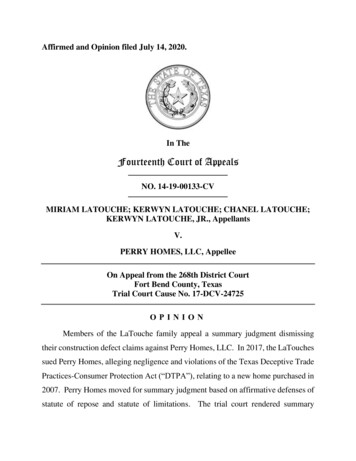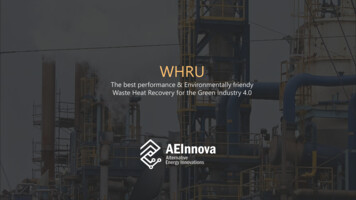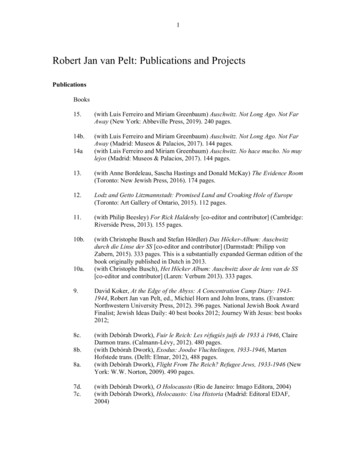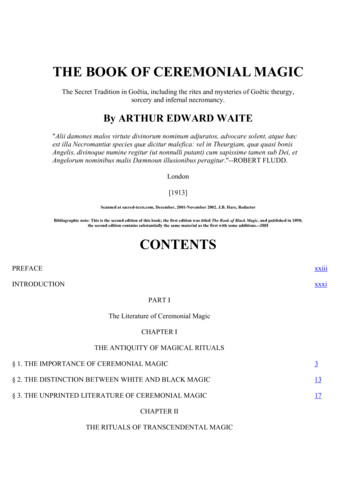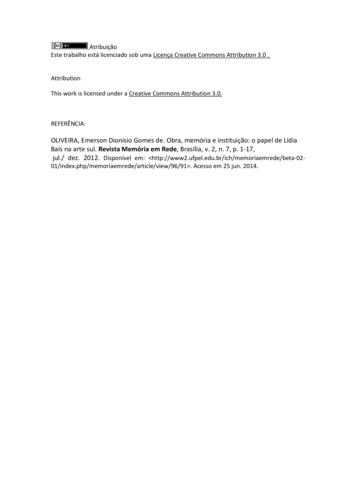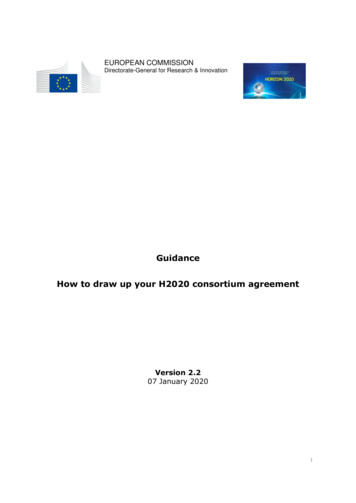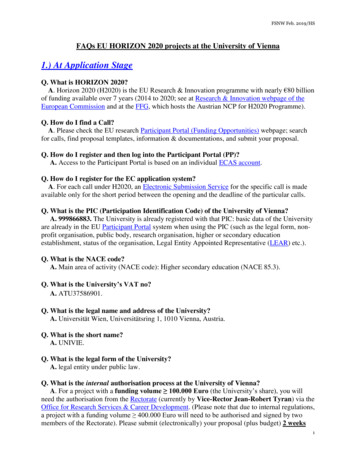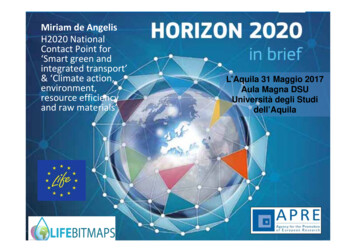
Transcription
Miriam de AngelisH2020 NationalContact Point for‘Smart green andintegrated transporttransport’& ‘Climate action,environment,resource efficiencyand raw materials’L’Aquila 31 Maggio 2017Aula Magna DSUU iUniversitàità ddeglili StStudididell’Aquila
Agenda1. Intro to Horizon 20202. Societal Challenge 5 ‘Climate action,environment, resource efficiencyy andraw materials’ in 2018/20
What is Horizon 2020The new EU Framework Programmefor Research and Innovation, 2014-2020 A budget of 78 billion for 7 yearsWhat's new? Coupling research to innovation – from research to deployment Focus on the challenges that the EU society is facing, e.g. health, cleanenergy, transport, Simplified access for participants A single programme bringing together three previously separateprogrammes/activities**the 7thh Research Framework Programme (FP7), innovation aspects of Competitiveness and Innovation FrameworkProgramme (CIP), EU contribution to the European Institute of Innovation and Technology (EIT)
H2020 ARCHITECTURE
Excellent ScienceIndustrial Leadership EEuropean ResearchRh CouncilCil Frontier research by the bestindividual teams LLeadershipd hi ini enablingbli anddindustrial technologies Nanotechnologies, AdvancedMaterials, AdvancedManufacturing and Processing,andd Biotechnology;Bi t h l Information and CommunicationTechnologies (ICT); Space Access to risk finance Leveraging private finance andventure capital for research andinnovation Future and Emergingg g Technologiesg Collaborative research to opennew fields of innovation Marie Skłodowska Curie actions Opportunities for training andcareer development Research infrastructures (includinge‐infrastructure) Ensuring access to world‐classfacilities Innovation in SMEs Fostering all forms of innovationin all types of SMEsSocietal Challenges1. Health, demographic change andwellbeing2. Food Security, SustainableAgriculture and Forestry, Marine,Maritime and Inland WaterResearch and the Bioeconomy3. Secure, clean and efficient energy4. Smart, green and integratedtransport5. Climate action, environment,resource efficiency and rawmaterials6. Inclusive, innovative andreflective societies7. Secure societyEuropean Institute of Innovation and Technology (EIT)Spreading Excellence and Widening ParticipationScience with and for societyJoint Research Center (JRC)
RULES FOR PARTICIPATION6
Legal entities that may participate in actions (art.6, RfPRfP*)/)/Eligibility for funding (art.9, RfP)WHO CAN BE FUNDED?WHO CAN PARTICIPATE?Any legal entity, regardless of its place ofestablishment, or international organization: Any legal entity established in an EU MemberState or Associated Country to H2020 (listedhere) Joint Research Centre (JRC) Any international organization.This information is included inthe General Annex to the mainWork Programmes,downloadable here Any legal entity established in a Member State andAssociated Country. JRC Among Third Countries: Low‐income countries(Former ICPC countries) (in the General Annex) Any international European interest organization. Any legal entity established in a Third CountryInternational organizations or legal entities established in a HIGH INCOME third country, in a BRIC (Brazil,Russia, India, China) country or in Mexico DO NOT RECEIVE AUTOMATIC FUNDING. They get funding: only if the participation is deemed essential for carrying out the action if it is foreseen by the Work Programme if funding is provided for under a bilateral scientific and technological agreement Joint Calls with third countries or international organizations*Horizon 2020 Rules for Participation, downloadable here
DEFINITIONS (art.2, RfP)‘LEGAL ENTITY’The participation of entities withoutg plegalpersonalityy is allowed as far asthey may, acting in their own name,exercise rights and be subject toobligations.Any legal person created under thenational law of its place ofestablishment, or underCommunity law or internationallaw which has legal ��NONPROFITLEGAL ENTITY’A legal entity which by its legal form isnon‐profit‐makingnonprofit making or which has a legalor statutory obligation not to distributeprofits to its shareholders or individualmembers (Article 2 of the Rules forParticipation and Dissemination)
Minimum Conditions for participation (art.9, RfP)3 LEGAL ENTITIES independent of each otherandd establishedt bli h d iin differentdifftMMemberb StStatest orassociated countries.1 LEGAL ENTITYERC, SME Instrument, Co‐fund actions, CSAand Marie S. Curie Actions.ADDITIONAL/SPECIAL CONDITIONS might beidentified in the work programme or work plan (n.(n of participants,participantstype of entities, etc )
TOOLS FOR PARTICIPATION
PARTICIPANT PORTALThe ParticipantThP ti itPPortalt l iis thethsingle entry point forelectronic administration of Public accessEU funded research andEU‐fundedinnovation projects, and hoststhe services for managing yourproposals and projectsthroughout their lifecycleECAS tal/desktop/en/home.html
12
13
CallWork programmeTopic
TOPICS structure
TOPICS structureSPECIFIC CHALLENGE sets the context, the problem to be addressed, why intervention is necessarySCOPE delineates the problem, specifies the focus and the boundaries of the potential action BUT withoutddescribingb specificf approacheshEXPECTED IMPACT describedb theh keyk elementsloff whath is expectedd to beb achievedhd in relationlto theh specificf challengeh llTYPE OF ACTION e.g. Research and Innovation Action (RIA), Innovation Action (IA), SME instrument; exc.
Societal Challenge 5 ‘Climateaction,tienvironment,it resourceefficiency and raw materialsmaterials’in 2018/20
Preparatory work The EC lunched a targeted, on‐line stakeholder consultation for theselection of priorities. The 200 responses received indicated substantial adhesion to theevolution of the previous two SC5 work programmes. Thee coconsultationsu tat o wasas suppsupplementede e ted by ddialoguea ogue witht thet e Europeanu opeaInnovation Partnerships (EIPs) Water and Raw Materials, Climate‐KIC, EIT Raw Materials and relevant ETPs; and by two workshopsb i i togetherbringingt th SC5‐relevantSC5 lt JPIsJPI andd ERA‐NETs.ERA NET The SC5 Expert Advisory Group (AG) submitted its report on1st June 2016.2016
General features of the identifiedpriorities 1/2The SC5 strategic priorities identified for 2018‐2020 will: continue to pursue SC5's overall objective of helping to realise agreen economyeconomy, ii.e.e a circular,circular climate‐resilientclimate resilient economy,economy therebycontributing to achieving smart, sustainable and inclusive growth. addressadd ess tthee gglobaloba tatargetsgets set by tthee COP21OParisa s Agreement,g ee e t, ttheeUN's Sustainable Development Goals (SDGs), the global UrbanAgenda adopted in Quito and the Sendai framework for DisasterRi k Reduction.RiskR d ti implement high‐level EU policies including the 7th EnvironmentalAction Programme to 20202020, the Circular Economy,Economy the Energy Unionand the Arctic. Supportpp openp science and openp innovation, with attention to ethicaland gender issues.
General features of the identifiedpriorities 2/2 Five strategic priorities were identified for 20182018‐2020:2020 climate action after COP21; circular economy; innovative and resilient cities and rural areas; the water‐food‐energy nexus; enabling systemic transformation.transformationPlus, additional cross‐cutting issues (including raw materials).Within all priorities the importance of R&I support to the expansion of theknowledge base,base deployment and scale‐upscale up of technical,technical nature‐basednature based andsocio‐economic solutions, is stressed.Within all priorities, the call for such solutions require a betterunderstanding of behaviour,behaviour socio‐culturalsocio cultural dynamics and the systemicpotential of sustainable lifestyles. To ensure societal engagement andacceptance, multi‐stakeholder actions should be initiated.
Strategic priorities for 2018‐2020and translation into calls
1. Climate action in support of the Paris1AgreementActionsiwill:ill support the Paris Agreement’s goals on global warming and relevant EU policies andobjectives: i.e the Energy Union, Arctic policy, EU Adaptation Strategy. Give special consideration to cooperation with strategic partner countries/regions. focus on: research on decarbonisation (focus on critical sectors such as land use andagriculture); assessments of impacts, vulnerabilities and risks for enhancing resilience of humansystems and ecosystems; facilitating market development of climate services; enhancing, understanding and supporting the development and use of nature‐based solutions,, greengand blue infrastructure,, exc.;; assessment of the impacts of climate change on vulnerable areas such as oceansand the cryosphere (main focus on the Arctic); addressddrelevantliissueswithi h a viewi to producingd i policy‐relevantlili finformationi fformitigation and adaptation.
2. Circular economyActionsAti( i l Innovation(mainlyIti actions,ticomplementedlt d byb R&I actions)ti ) will:ill Focus on transition to a circular economic model, with products,processes and business models designed to reduce environmentalimpacts. Address the full range of product lifecycle stages in order to reducethe quantities of raw materials in production and consumption andfacilitate the use of secondary raw materials. (Priority areas includeplastics, critical raw materials, construction and demolition, andwater use and reuse) investigate the consequences of transition to the circular economy,in order to identify policies that can effectively support thetransition and mitigate its potential adverse effects. Aspects such as public acceptance and collaborative economymodels are considered. Greater integration of digital solutions insupportpp of the circular economyy is considered as essential.
3. Water for our environment,3environment economyand societyActions will:will focus on boosting both the EU water market and the globalcompetitiveness of the EU water sector and water‐related/‐dependentindustries and economic sectors,sectors address innovative water technologies, services and monitoring tools,digital solutions, living labs and large scale demonstration projects withvarious water uses (industrial,(industrial urban,urban rural and agricultural) and at variousscales (regional/national/international river basins) and integratedapproaches,above‐ mentioned (improve risk and impact assessments related to the abovechallenges (R&I actions), promote water diplomacy with key international partners and regions (e.g.gof trans‐boundaryy river basins))for the management support the implementation of the PRIMA initiative (Partnership forResearch and Innovation in the Mediterranean Area).
4 Innovating cities for sustainabilityand resilience Mainly large scale demonstration projects, with cities acting as ‘living labs’and engaging stakeholders in open innovation and co‐creation to develop,pin real‐world conditions innovative NBS.test and replicateEmphasis will be on NBS for air, noise and water quality, climateadaptation and decarbonisation, human health and well‐being, anddisaster risk reduction in cities, encompassing all forms of innovation( h l(technological,l digital,dl social,l institutional,l financial,fl regulatorylanddgovernance).Complementary research actions are foreseen to better quantify thebbenefitsfit off NBS ini cities.itiSynergies with other relevant parts of H2020 promote integratedapproaches to improve urban ecosystem functioning, combining 'hard'(such as energy,energy transport),transport) 'soft'soft (such as active mobility,mobility data,data ICTICT,sensors) and environmental systems (habitats, green space and greeninfrastructure).
5. Raw materials AActionstiwillill cover theth entireti EU raw materialst i l valuel chain,h ifrom sustainable exploration, extraction, processing(including metallurgy) to recycling, as well as substitution ofCRM. In an 'open innovation' approach, actors from the wholeinnovation chain will be involved,involved including researchers,researchersindustry, end‐users, public authorities and civil society. The main focus will be on supporting the targets of the EIPon Raw Materials,i l includingi l di largelinnovativeii actionsif EUforraw materials production. Breakthrough research concepts,concepts as the basis of tomorrowtomorrow'ssinnovations, will also be tackled through smaller, lower‐TRLactions.
6. Protecting and valorizing our naturaland cultural assets‐ Earth observationActions will target the following priorities: delivering EO services by exploiting GEOSS, Copernicus and other availableEO data and by addressing the full innovation chain from innovative ideasto pre‐commercial deployment, focusing on developing andddemonstratingi innovativeii mass marketk applicationsli if bforbusinessesianddcitizens; developing a regional GEOSS strategy for Europe to enable and improvecapacitiesiti forf ththe discovery,diaccess, integrationi tti andd use off EO ddatat offdifferent types and origins (from space to ground), across platforms andfor various communities of users; contributing to selected GEO flagship activities of high strategic value tothe EU and its international commitments (such as the 2030 Agenda forSustainable Development and the G7).Things R&I activities combining with ICT advances such as the Internet of Things,big data analytics and cloud processing, these
6. Protecting and valorizing our naturaland cultural assets‐ Nature based solutions, disaster risk reduction and naturalcapital accounting Actions will support multi‐stakeholder demonstrationprojects on nature‐based solutions to protect andenhance biodiversity and ecosystems, and to increasethe resilience of territories to disasters and hazards,and the capacity to restore degraded habitats,habitatsecosystems and biodiversity. R&I actions will focus multi‐hazardmulti hazard risk managementand cascading impacts, as well as early‐warningsystems,y, forecasting,g, monitoringg and reportingpgcapabilities for geo‐hazards (such as earthquakes).
6. Protecting and valorizing our naturaland cultural assets‐ Heritage alive Large scale 'livingliving labslabs' demonstration projectsare foreseen to engage relevant stakeholders inopen innovation and co‐creation to design,develop and test solutions, integrating naturaland cultural heritage with new innovationparadigms and business,business governance andfinancing models. R&I actions are foreseen to enhance the capacityto predict, assess and mitigate the direct andindirect impactp of gglobal changeg on culturalheritage.
Thank you!Miriam de Angelismdeangelis@apre.it
The new EU Framework Programme What is Horizon 2020 for Research and Innovation, 2014-2020 A budget of 78 billion for 7 years What's new? Coupling research to innovation -from research to deployment Focus on the challenges that the EU society is facing, e.g. health, clean energy, transport, Simplified access for participants
